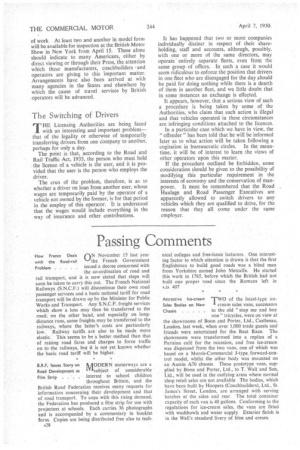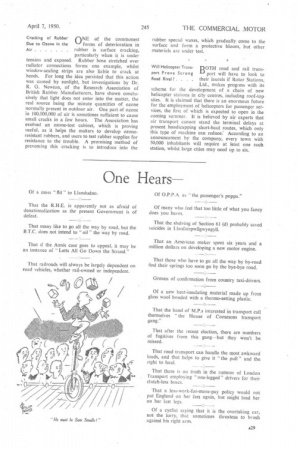Passing Comments
Page 30

Page 31

If you've noticed an error in this article please click here to report it so we can fix it.
How France Deals (IN November 15 last year with the Road-rail `—•the French Government Problem issued a decree concerned with
the co-ordination of road and rail transport, and it is now stated that steps will soon be taken to carry this out. The French National Railways (S.N.C.F.) will discontinue their own road passenger services and a basic national tariff for road transport will be drawn up by the Minister for Public Works and Transport. Any S.N.C.F. freight services which show a loss may then be transferred to the road; on the other hand, and especially on longdistance runs, some freights may, be transferred to the railways, where the latter's costs are particularly low. Railway tariffs are also to be made more elastic. This seems to be a better method than that of raising road fares and charges to force traffic on to the railways, but it is not yet known whether the basic road tariff will be higher.
B.R.F. Issues Story on NAODERN motorways are a Road Development as ''subject of considerable
Film Strip . . . . interest to school children
throughout Britain, and the British Road Federation receives many requests for information concerning their development and that of road transport. To cope with this rising demand, the Federation has produced a film strip for use with projectors at schools. Each carries 36 photographs and is accompanied by a commentary in booklet form. Copies are being distributed free also to tech nical colleges and free-lance lecturers. One interesting factor to which attention is drawn is that the first Englishman to build good roads was a blind man from Yorkshire named John Metcalfe. He started this work in 1765, before which the British had not built one proper road since the Romans left in A.D. 407 Attractive Ice-cream 'TWO of the latest-type ice Sales Bodies on New I cream sales vans, successors Chassis to the old "stop me and buy one" tricycles, were on view at the showrooms of Boon and Porter, Ltd., Castlenau, London, last week, when over 1,000 trade guests and friends were entertained for the Boat Race. The showrooms were transformed into a replica of a Parisian cafe for the occasion, and free ice-cream was dispensed from the two vans, one of which was based on a Morris-Commercial J-type forward-control model, whilst the other body was mounted on an Austin A70 chassis. These prototype vans, supplied by Boon and Porter, Ltd., to T. Wall and Son, Ltd., will be used in the outlying areas where normal shop retail sales are not available The bodies, which have been built by Hoopers (Coachbuilders), Ltd., St. James's Street, London, are arranged with serving hatches at the sides and rear. The total container capacity of each van is 40 gallons. Conforming to the regulations for ice-cream sales, the vans are fitted with washbowls and water supply. Exterior finish is in the Wall's standard livery of blue and cream. ONE of the commonest : forms of deterioration in rubber is surface cracking, particularly when it is under tension and exposed. Rubber hose stretched over radiator connections forms one example, whilst window-sealing strips are also liable to crack at bends. For long the idea persisted that this action was caused by sunlight, but investigations by Dr. R. G. Newton, of the Research Association of British Rubber Manufacturers, have shown conclusively that light does not enter into the matter, the real source being the minute quantities of ozone normally present in outdoor air. One part of ozone in 100,000,000 of air is sometimes sufficient to cause small cracks in a few hours. The Association has evolved an ozone-test cabinet, which is proving useful, as it helps the makers to develop ozoneresistant rubbers, and users to test rubber supplies for resistance to the trouble. A promising method of preventing this cracking is to introduce into the
Cracking of Rubber Due to Ozone in the Air
rubber special waxes, which gradually come to the surface and form a protective bloom, but other• materials are under test.
Will Helicopter TransROTH road and rail transport Prove Strong " port will have to look to Road Rival ? . . . their laurels if Rotor Stations,
Ltd., makes progress with its scheme for the development of a chain of new helicopter stations in city centres, including roof-top sites. It is claimed that there is an enormous future for the employment of helicopters for passenger services, the first of which is expected to open in the coming summer. It is believed by air experts that air transport cannot stand the terminal delays at present handicapping short-haul routes, which only this type of machine can reduce.' According to an announcement by the company, every town with 50,000 inhabitants will require at least one such station, whilst large cities may need up to six.
































































































